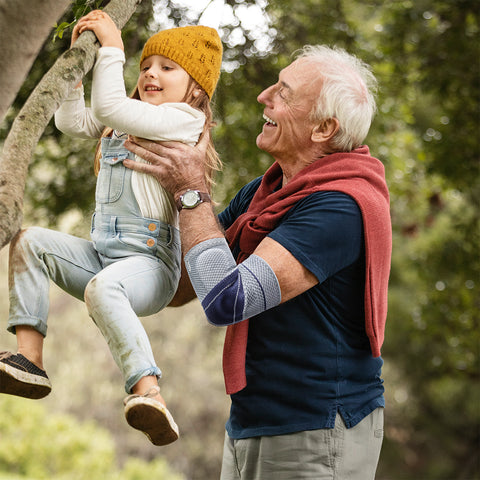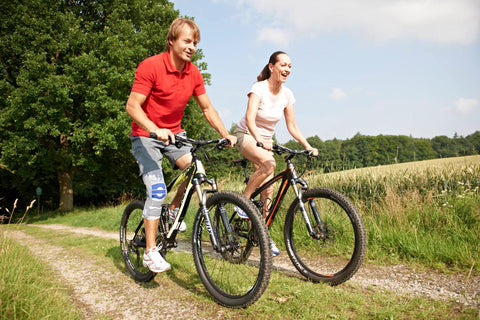Anatomy of a ‘good’ brace
But first, what makes a brace good? Purpose, quality, and fit.
- Purpose: You’ll need a brace designed to help with your injury type. Simply put, a brace intended for a relatively minor injury like a jumper’s knee won’t be suitable for an ACL rupture. While a Jumper’s Knee brace like our GenuTrain will have some similar benefits as one intended for a ruptured ligament, they will be softer in structure and thus won’t offer the same level of support.
- Quality: medical-grade materials are key, both for helping you recover from your injury and for long-wearing comfort. That means medical-grade compression knit, stays or splints that can withstand your body weight, and straps that won’t unstick as you move around. Additionally, you want a brace with good heat management, soft materials, and minimal slippage so it won’t get uncomfortable after just a couple of hours of wear.
- Fit: last but not least, a good brace is one that fits you perfectly. Without a perfect fit, you simply won’t get the right support you need to heal, risking more pain and potentially re-injury. Generic sizing systems or a one-size-fits-all approach typically won't be suitable, comfortable, or effective in helping you recover.
With that sorted, let’s explore what makes good braces so important for injury recovery.
Braces facilitate movement
While some bed rest may be necessary (especially after something as serious as a fracture), most medical professionals will tell you to get up and moving as soon as possible. That’s because our bodies are built for movement: the muscles need it to stay strong, cartilage and blood vessels need it to circulate nutrients, and tendons need it to remain flexible.
Of course, you can’t expect to put your whole body weight onto an injured joint without issue, and that’s where braces come in handy. They’ll help offload pressure away from the site of injury, letting you keep the joint mobile without risking further damage.
When necessary, they limit movement

GenuTrain S Pro
For certain injuries, though, you’ll need to avoid moving your joint in some directions (and in some cases, avoid moving it at all). With an ACL rupture, for example, flexing your knee too far can pull the healing tissues back apart, making the healing process go back to square one. That’s why our GenuTrain S Pro has a hinge system that lets you limit your knee’s flexion range at 30, 60 and 90 degrees as well as extension at 20 degrees. You can still walk and move the joint without risking further damage.
Learn more: Which Knee Brace is Best for a Knee Ligament Injury
Relieve pain

EpiTrain Elbow Brace
Quality braces (especially those built for injury recovery) can also do a lot for pain relief. As we mentioned, braces can help redistribute load away from your injury, helping you avoid the pain that flares up with pressure. Braces also often incorporate padding, which helps minimise the pain that comes with general movement (like lifting your arm or flexing your fingers when you have elbow tendonitis). Our EpiTrain Elbow Brace, for example, includes Epicon pads sewn into the inside and outside of the elbow joint to massage key areas around the epicondyle tendons, relieving the pain you’d commonly feel with conditions like Tennis Elbow and Golfer’s Elbow.
Learn more: How to Choose the Right Elbow Support for your Injury
Reduce swelling
When it comes to acute injuries, swelling is unavoidable. But while this natural bodily response is instrumental in the first stages of injury recovery, our bodies sometimes can overreact and cause more harm than good.
Too much swelling can limit mobility, result in even more pain when you try to move or put pressure on the joint, and even limit the amount of blood (and by extension, oxygen and nutrients) getting through to your injured joint, slowing down recovery.
That’s where compression knit comes into play. We incorporate this specialised fabric in braces like our EpiTrain and GenuTrain to gradually compress the injured area, boosting circulation to move excess fluid out and oxygen and nutrients back in. In essence, you get two products in one: a compression device coupled with a joint support.
Speed up recovery

On that note, bracing also means a speedier recovery.
- Injured tissues will get the nutrients they need to heal at a faster rate through compression.
- Increased support means you can avoid further damage.
- And lastly, being able to move the joint even with certain limits in place will further improve blood flow and keep the surrounding structures strong. So, you can generally ease back into your regular activities quicker (with your doctor’s go-ahead, of course).
Other steps you can take to help the injury recovery process
- Rest. As we mentioned, rest is often necessary in the few days after even a minor injury, and your doctor may recommend a longer rest period after a severe one. It will let your body do what it needs to do without being disturbed by excess pressure and movement.
- Ice and heat. Ice can often relieve some pain and reduce swelling. Generally, ice works best for the first 3-5 days after an acute injury. Just be mindful of how often and for how long you use this method, as the cold narrows blood vessels. Heat, meanwhile, can help ease the muscle tension that can set in after long periods of inactivity. However, as it expands blood vessels, it can exacerbate swelling, so avoid using it for the first 3-5 days after injury.
- Elevation. Especially around the legs and extremities, long periods of rest mean the veins can’t pull blood to the heart as efficiently, slowing down circulation and nutrient delivery to the injury site. So, aim to elevate that body part at or above heart level to let gravity help the process along instead of hindering it.
- Gentle exercise. Now, this is only really applicable to cases where you don’t need to immobilise the joint. But some gentle strengthening exercises and stretches will help further improve blood flow around the injury, strengthen the joint against re-injury, and keep your tendons flexible to avoid future mobility issues.
To sum up
Braces compress, support, and minimise pain and swelling around injured joints, so they're an important step in injury recovery. Just be mindful of the type of brace you get. And as always, take some additional precautions like getting your doctors' advice and following the RICE (rest, ice, compression, elevation) method.


















